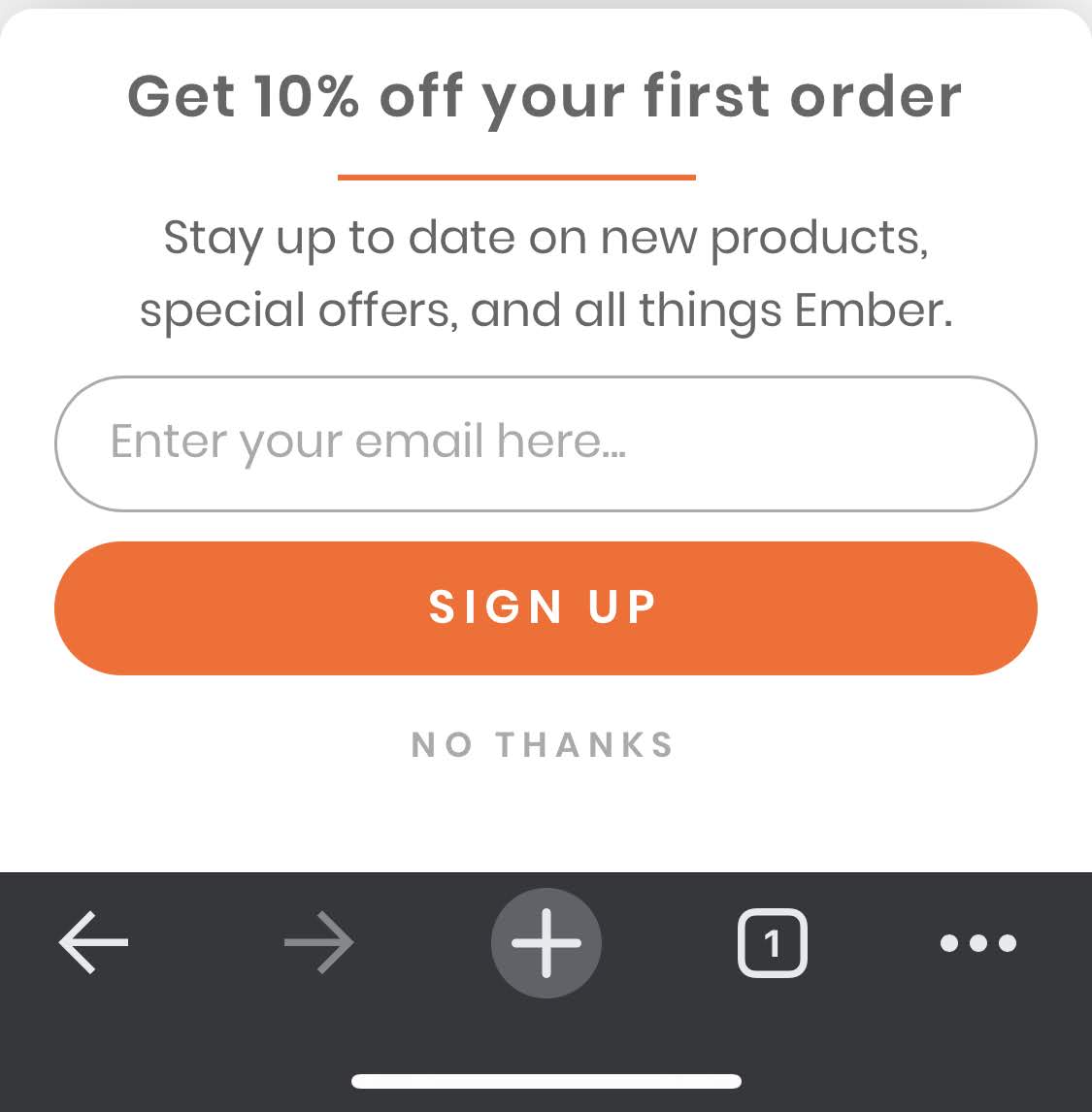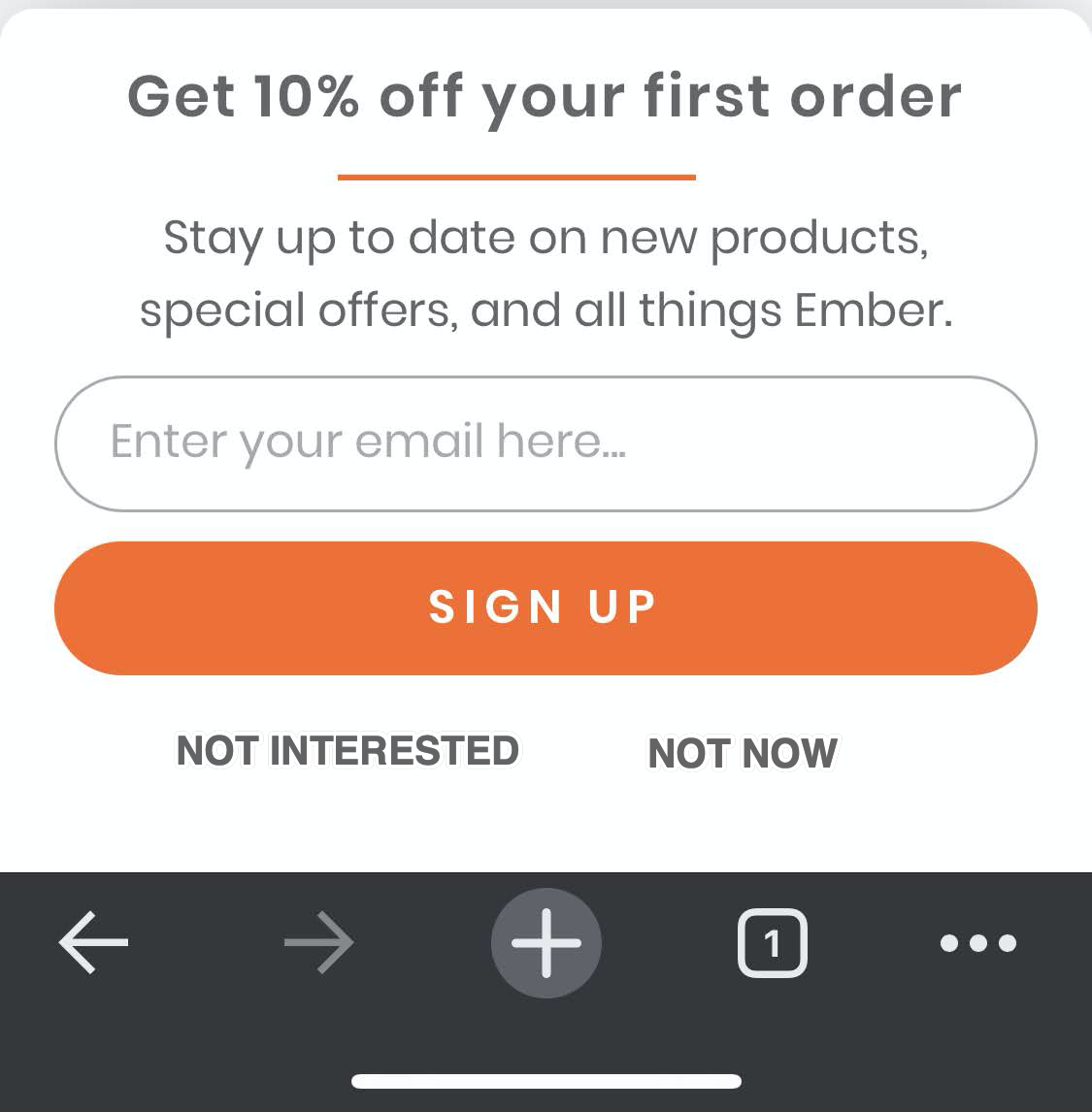Blog
Buyer Psychology of Email Popups
Email popups are a necessary evil. But 98.05% (link) of visitors close the popup message.
If you leverage buyer psychology you can double your signup rates.
What’s Buyer Psychology?
It’s the study of shopper behavior. As much as we like to believe each person is totally unique we behave in very predictable ways. By understanding the psychology of site visitors we can better connect with them. By better connecting, we can do a better job conversating (is that a word?) with them.
We talk about buyer psychology extensively in this article: CHAPTER 2: Buyer Psychology.
How to Double Email Popup Signup Rates Using Buyer Psychology
I was on ember.com and saw this popup:

To double signup rates I would make 2 tiny tweaks:

Changes: now the button on the left says NOT INTERESTED (this is for people who simply don’t want to signup) and the button on the right says NOT NOW.
You see, most visitors are interested, they just might not be ready at this very moment. In my scenario, this pop-up message appeared while I was reading their Travel Mug (link) details. So while I am interested in a 10% discount (who wouldn’t be) I had to get rid of the message because it was blocking my mobile view.
Functionality: when people pick NOT NOW the popup will disappear immediately and return later (this could be set based on time on site or number of pages visited). The next time the user is much more likely to convert.
An Added Benefit
In the original design, the only data being collected is how many people are clicking NO THANKS. But this isn’t rich data because as we saw in our example many people are interested, just not now. By collecting NO THANKS stats the retailer is likely drawing the wrong conclusion about their shopper intent. In the new design, we’re collecting richer data.
NOT INTERESTED– this is a pure count of people who aren’t interested. There is a very low probability of a false positive (link) because the user has 2 choices. If they are clicking NOT INTERESTED it’s because they really aren’t interested. So we’re collecting real data on shopper psychology.
NOT NOW– this button is revealing people who are interested (just not now). But it has another hidden benefit, something that will shed even more light on buyer psychology. And that’s this: say we program the site so that when NOT NOW is clicked the signup prompt disappears for 3 more pageviews. Let’s assume 60% of visitors click NOT NOW but only 9% signup when it reappears. This is a signal that we need to adjust the timing of the second prompt (it’s appearing too late).
Further Reading
We hope you enjoyed this article that talked about what a Picture Story is and how to use it to maximize conversion rates.
We’ve spent the last 16 years in our marketing lab, experimenting on online shoppers. We’ve learned a crap ton and are ready to share those learning.
Here is a recap of everything we’ve learned:
Revelation 1: The most important page on your entire site is your product page. To understand why this is, read this post: Product Page Optimization.
Revelation 2: For every 1,000 product pitches encountered the shopper buys one item (and we’re being generous). If you want the consumer to choose your product your need to understand their new product selection criteria. You need to understand the 9 truths about online shoppers.
Revelation 3: Now that you understand the selection criteria described in the previous step we need to use them to construct our sales pitch. The sales pitch is your unfair advantage.
About Frictionless Commerce
We deliver an unfair advantage to technical product DTC brands (for example, Dyson) by improving advertising effectiveness by 20% in 90 days. This is achieved using a buyer psychology conversion copywriting framework. All paid traffic eventually reaches the product page and this is where we strike. Our process.
If you like doing the hard work yourself, our founder Rishi shares conversion ideas on LinkedIn every day. Connect with him here.
If you want to make your life easier and still increase conversions, jump on a call.




Comments 2
Interested
ReplyRishi Rawat
Hi, John. Thanks for the comment. Let me know what information you are interested in digging into and I’ll prepare it for you.
Reply